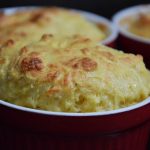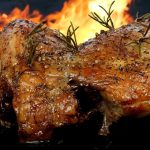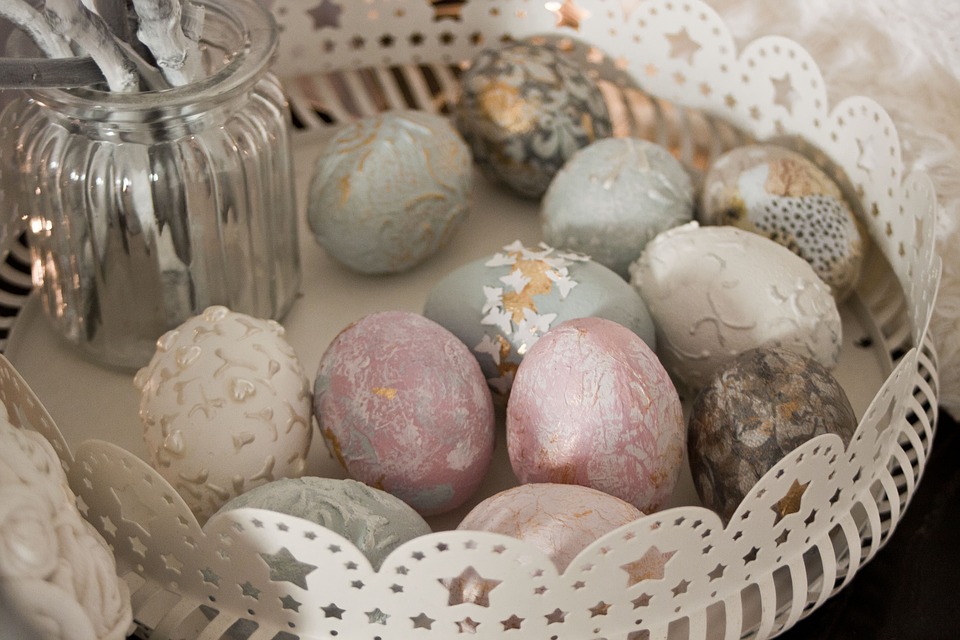So, what is everyone doing for Easter this year? Mine will be busy, with my three children, their other halves, little granddaughter, my mother, and my partner – all round for a feast. Add the two cats and dog and, well, it’s not going to be a quiet sedate affair. But who wants quiet?!
We’re not going traditional this year, but having a Chinese buffet. It got me wondering, what IS a traditional Easter meal? Well, this depends where you live of course. The foods across the world tend to reflect foods not eaten during Lent, so using up preserved eggs and vegetables in particular.
Easter food here in the UK tends to be Hot Cross Buns, and a lovely lamb roast. If in Greece, you’re likely to tuck into a hefty Lamb Soup filled with herbs, vegetables and rice. Similarly, in Poland a white Borscht made with a polish sausage and potatoes makes a change from the red beetroot version. The Sicilian Easter lunch is likely to be a Lamb Pie. Other European countries are also likely to tuck into pastry-covered delicacies; in Spain, you’d be tucking into a savoury meat and egg pie for your Easter lunch, and in Italy a spinach and ricotta pie with eggs in the middle. In Brazil you’ll be tucking into salt cod, and pickled herring in Sweden.
The traditional Farmhouse Kitchen Easter feast would usually be a filling affair.

To start, let’s show off with a cheese soufflé.
Don’t panic, they really aren’t as hard as 1970s TV programmes will have you believe. But, your guests don’t have to know that!
5 eggs (separated)
100g butter
500ml milk
100g plain flour
125g grated cheese
Salt & pepper
Make a standard roux with the butter, flour and milk, and then add the cheese, salt and pepper. Once the cheese has melted, remove from the heat and allow the sauce to cool. Add the egg yolks to the cooled sauce.
Whisk the egg whites until you achieve sharp peaks. Then gently fold the whites into the sauce. Don’t stir this, but instead use the minimum effort to ensure you don’t lose the air you’ve whisked in.
Pour the mixture into ramekins you’ve already greased in preparation, and bake at 180° for 10 minutes – the soufflé will be risen and golden.
 If you fancy the perfect roast for Easter, grab a leg of Lamb. Make sure the joint has been brought up to room temperature if it’s been stored in the fridge. Spend a little time on the seasoning; garlic, rosemary and redcurrant jelly combined with a little olive oil and rubbed into the meat before you roast it enhances its natural sweet flavour.
If you fancy the perfect roast for Easter, grab a leg of Lamb. Make sure the joint has been brought up to room temperature if it’s been stored in the fridge. Spend a little time on the seasoning; garlic, rosemary and redcurrant jelly combined with a little olive oil and rubbed into the meat before you roast it enhances its natural sweet flavour.
Set the joint on a wire rack in a roasting tin to enable the fat and juices to fall under the meat. Roast the meat at a steady 170°, allowing 30 mins per 500g. Test it’s ready by piercing with a skewer (choose the thickest part of the joint) and ensure the juices run clear. When cooked, set the joint to rest for about 15 minutes.
Use this time to make a yummy gravy. Using the juices you allowed to drain under the meat, pour them into a jug and skim off the worst of the fat. Take the tin you roasted in, and heat a little fat in it on the hob. Stir in a tablespoon of flour or cornflour; cook this in for a minute. Then, pour in the juices you set aside. Top this up with about a pint of meat stock (a stock cube is perfectly acceptable). Bring the gravy to the boil, and simmer for 10 minutes. If you’re not happy with the richness of the colour, a couple of teaspoons of gravy browning will help.
You can, if you wish, add more rosemary and/or red currant jelly into the gravy.
Serve your lamb and home-made gravy with some crunchy, fluffy, roast potatoes and vegetables of your choice. Don’t forget the mint sauce!
As it’s Easter, treat yourself to a decent wine to accompany your roast. Being a red meat, red wine is the perfect match. Try a Malbec or a Pinot Noir. Or, if you’re not really a red-wine drinker why not treat yourself to a bubbly rosé Champagne instead.
For dessert, why not ‘posh up’ a good old British bread and butter pudding.
8-10 slices brioche
340ml milk
56ml cream
2 eggs
30g sugar
Chosen flavourings
In an oven-proof dish, layer triangles of buttered, Brioche slices. Now add your preferred flavouring – eg chocolate could mean spreading at least half the slices with chocolate spread and/or a couple of handfuls of chocolate chips; try orange segments, with zest and a squeeze of the orange juice; or spread the bread with jam and add matching fresh fruits, or anything else you fancy.
Make a custard; start by warming the milk and cream, but don’t let it boil. Whisk the eggs with most of the sugar (set around ⅓ to one side). Once pale and creamy, add the milk to the eggs and stir well. Pour the custard over your bread slices. Get your hands stuck in, ensure that all the bread is pushed into/covered by the custard. Set the pudding aside to let the milk soak in for a good 30 minutes or so (you can do this step the night before and leave this soaking in overnight in the fridge).
Sprinkle the top of the pudding with the remaining sugar, directly before you pop it in the oven.
Bake at 180° for around 30 minutes, the custard should be set and the top golden and crusty.
If that’s not enough food for one day, as let’s face it everyone will have stuffed themselves with chocolate Easter eggs and hot cross buns already, other little sweet treats go down well.
Easter baskets
 Melt some chocolate, and stir in some cornflakes. Ensure you cover all the cereal with the chocolate. You can add some chocolate chips, raisins or smarties if you like. Fill little paper cases with the cornflake mix, smoothing the top to look fairly flat. Then sit some little mini-eggs on top – 2 or 3 per nest should be fine. Pop them in the fridge to set.
Melt some chocolate, and stir in some cornflakes. Ensure you cover all the cereal with the chocolate. You can add some chocolate chips, raisins or smarties if you like. Fill little paper cases with the cornflake mix, smoothing the top to look fairly flat. Then sit some little mini-eggs on top – 2 or 3 per nest should be fine. Pop them in the fridge to set.
Showstopper cake
You can wow everyone with a unique celebration cake. Start with any cake of your choice – made or (gasp) bought.

Depending on how you then want to decorate it, cover the cake with either a chocolate ganache (melted chocolate and cream), whipped fresh cream, or a buttercream icing. Indeed, if you’re not confident in handling cake that’s covered completely, just cover the top and trim the cake with a complementary ribbon.
Chocolate decorations can include: mini eggs, smarties, mini chocolate animals (eg bunnies), glamorous chocolate decorative shapes you’ve piped yourself, chocolate shavings or even steal out of a box of your favourite choccies.
You may match one or a mix of fresh fruit with a cream topping, raspberries, strawberries, grapes, orange segments (pith and membrane removed), redcurrants, blueberries etc.
Topping with fake or fresh (washed) flowers can be stunning. If you do this, keep it simple. Maybe a tiny little bunch of a few flower-heads and a couple of leaves set to one side of the top of the cake. Or, go the whole hog and make your own sugar flowers with icing.
Make sure you display your cake on a pretty platter, for maximum admiration and appreciation from your guests.
Whatever you do this Easter, enjoy it – you’ll soon be back to work!
love
Maggie x


I like the valuable information you provide in your articles. I will bookmark your blog and check again here regularly. I am quite certain I’ll learn lots of new stuff right here! Good luck for the next!
Thank you Nick, I hope you tried making your own eggs and I hope you continue to enjoy my blogs.
love
Maggie x
I like the helpful info you provide in your articles. I will bookmark your weblog and check again here regularly.
I got what you mean,saved to fav, very decent site.
sound like you know what you?re talking about! Thanks